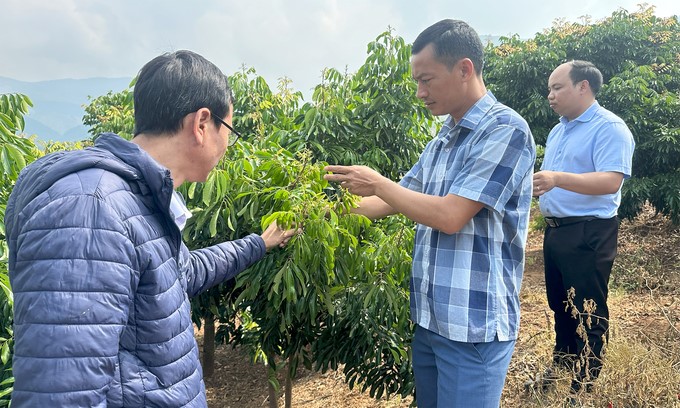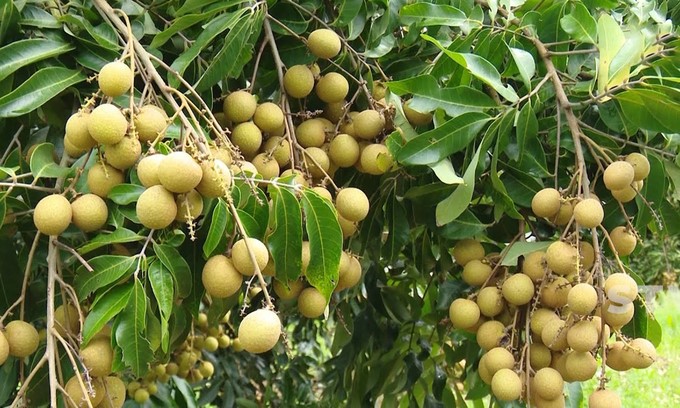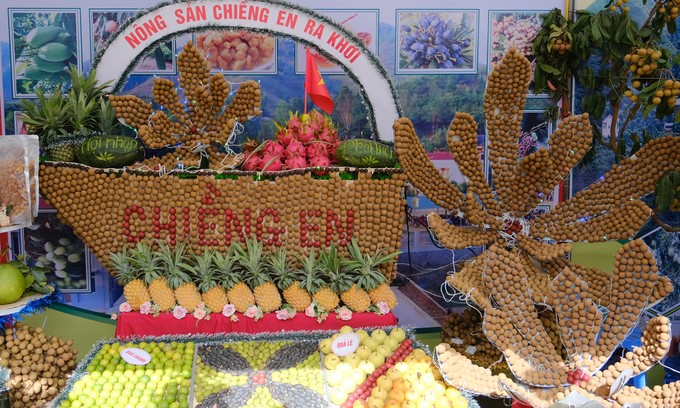May 18, 2025 | 02:58 GMT +7
May 18, 2025 | 02:58 GMT +7
Hotline: 0913.378.918
May 18, 2025 | 02:58 GMT +7
Hotline: 0913.378.918

Mr. Luong Van Muoi (right) takes care of the longan garden. Photo: Duc Binh.
As a person with decades of experience in longan growing, Mr. Luong Van Muoi, Director of Hoa Muoi Agricultural Service Cooperative in Song Ma district, Son La province, said that the cycle of exploiting and caring for longan trees is very long. Starting from the 3rd year, longan can bear fruit. Therefore, during this time, people should actively visit the garden, especially in the flowering and fruiting stages. In addition to applying additional fertilizer, pruning is also very important so that the tree "puts effort" into growing fruit and producing evenly large fruit with beautiful design, thick flesh, and sweet juice.
"Normally, I only leave about 50–70 of the bunches," Mr. Muoi shared his secret. According to the typical farmer nationwide in 2024, households in Song Ma previously had the habit of cultivating with local longan. Due to not paying attention to pruning branches and creating a canopy, the fruits are often uneven. The nutrient content, sweetness, and flesh hardly meet export standards. It is also difficult to ensure tree health; the costs of fertilizer and pesticides are also higher.
During the flowering time, the tree needs a lot of water to help the flowers bloom simultaneously and develop well. In the blooming period, if it rains, people need to shake the tree so that the water on the inflorescences and withered petals falls off, creating conditions for the inflorescences to dry quickly, thereby enhancing the flower's ability to release pollen and avoiding creating a favorable environment for harmful fungi.
In the fruit-bearing period, without water, the fruit will not grow. Productivity and quality will be seriously affected. Therefore, Mr. Muoi always ensures watering and maintaining humidity for the tree. In particular, when entering maturity, the fruit has grown relatively fully and entered the stage of accumulating and metabolizing substances in the fruit. At this time, people absolutely avoid watering too much, because excess water combined with hot conditions in the summer months can cause fruit cracking, creating conditions for fungal diseases to develop and cause damage.
Longan can ripen at different times, so it is necessary to harvest on dry days. Harvesting should be done in the morning or late afternoon, avoiding harvesting at noon when it is too hot to ensure the product's quality and the harvester's health.
Before harvesting, people should observe and select areas where the fruit changes from greenish brown to yellow brown and the rough, slightly thick skin turns to thin and smooth. Edible longan fruit is usually soft, with fragrant flesh and the Brix level reaching about 20% (depending on the variety). If using logan to make dried longan flesh, people can harvest earlier, when the fruit reaches about 80–90% of maturity compared to eating fresh.

Song Ma district is promoting the area of growing early ripe longan. Photo: Duc Binh.
Mr. Luong Van Muoi revealed that post-harvest care measures are also very important, helping the tree quickly restore growth and serving as a basis for accumulating nutrients for flowering and fruiting in the next crop. During this period, a water shortage will prevent the tree from absorbing nutrients in the soil, slowing down the growth of buds. Buds grow stunted. More seriously, buds will wilt; old leaves turn yellow and may partially or completely fall off.
Thanks to the above-mentioned experiences, members and households participating in production linkage at Hoa Muoi Agricultural Service Cooperative have about 20 hectares of longan meeting VietGAP standards and are also granted 10 planting area codes for export to Australia, China, and EU markets by the Son La Sub-Department of Crop Production and Plant Protection.
Longan grown in Song Ma is currently mainly hybridized with Mien Thiet or T6 longans. Having grafted thousands of longan roots for farmers and cooperative members, Director Luong Van Muoi realized that for trees propagated by grafting, it is necessary to cut the tops to create level 1 or level 2 branches as soon as the tree has a height of 0.8–1 m. When level 1 or level 2 branches arise and grow an additional 0.5–0.7 m, continue to press the tops to create level 2 or level 3 branches, and so on until the tree has a skeleton and evenly distributed level 3 branches.
For cutting branches, leave 2-3 level 1 branches evenly distributed in all directions. When the level 1 branch is 0.5–0.7 m long, cut the top to create the next-level branch as for plants propagated by grafting.
After planting, longan trees need to be watered heavily to keep them moist. Besides, farmers must limit weeds around the root with straw or dry grass. During the first month, water is supplemented once every 2 days. In the following months, the irrigation cycle becomes less frequent and depends on the weather. If the weather is too sunny, farmers need to water continuously and take measures to shade the tree.

For many years, Song Ma district has periodically organized the Song Ma Longan Festival, attracting thousands of tourists. Photo: Bao Thang.
The entire Son La province currently has about 20,000 hectares of longan, of which 1/3 of the area is located in Song Ma district. In recent years, the district has coordinated with the Fruit and Vegetable Research Institute (Ministry of Agriculture and Rural Development) to promote growing early ripe longan (about 500 hectares as of now), with the selling price 2-3 times higher than main-crop longan.
Because not all people have enough capital and human resources to plant several hectares of longan in one crop, Mr. Muoi advises that "Whatever people do, get it right," starting right from digging holes. This seemingly simple step is also based on the principle of digging large holes in bad soil and small holes in good soil. The purpose of digging holes is to improve the chemical and physical properties of the growing land by making the soil loose, adding nutrients, and improving the pH of the soil.
The normal hole size (length x width x depth) is 0.8 x 0.8 x 0.6 m. In hilly areas with bad soil, larger holes need to be dug, with the corresponding size of 1 x 1 x 0.8 m. In key agricultural areas like Son La, where there is a relatively large amount of manure, farmers should fertilize about 30–50 kg of manure/hole. Along with lime powder and some other fertilizers, the entire amount of fertilizer is mixed evenly with the layer of soil dug from the hole, then backfilled. The work of preparing planting holes and fertilizing should be carried out about 1 month before planting.
Longan trees can be grown on many types of soil, from year-round freshwater areas to saline areas, but the most suitable are sandy soil, sandy loam soil, alluvial soil along rivers, and soil with a pH of 5.5–6.5. Longan is not suitable on heavy and too wet clay soils. Therefore, places that are often flooded during the rainy season need to dig ditches, build beds, or build mounds to avoid flooding. In low hilly areas like Song Ma, people can plant along contour lines. Notably, for newly growing gardens with an area of more than 5 hectares, it is necessary to divide plots, plan on-farm roads, and design rows of trees to block wind.

The area of Song Ma longan accounts for about 1/3 of the total area of the province. Photo: Bao Thang.
During the basic construction period, usually the first 2 years, people need to pay attention to digging trenches around the tree according to the canopy projection, with a width of 0.2–0.3 m and a depth of 0.2–0.25 m, while spreading organic fertilizer first, then covering with soil and watering.
The Son La Provincial Sub-Department of Crop Production and Plant Protection recommends that the best time for longan growing in the area is at the beginning of the rainy season, from late April to August. If farmers can be proactive in irrigation water sources, they proactively adjust crop schedules to plant earlier or later, depending on specific conditions and available agricultural materials.
Translated by Thu Huyen

(VAN) 14 out of 35 domesticated elephants in Dak Lak province have had their living conditions improved, with 11 of them currently participating in the non-riding elephant tourism model.

(VAN) Muong Nhe Nature Reserve hopes that being upgraded to a national park will lay the foundation for forest protection efforts to be carried out in a systematic, modern, and sustainable manner.
/2025/05/16/3923-2-171845_52.jpg)
(VAN) Lower costs, higher yields, and improved soil quality are outstanding benefits that soybeans bring when integrated into the crop rotation system.

(VAN) The 'For a Green National Environment' programme aims to promote a green lifestyle, support businesses in implementing ESG practices, and turn Net Zero commitments into concrete actions.

(VAN) Cold-barn systems efficiently manage environmental and temperature conditions, which aids in the prevention of respiratory diseases in pigs and protects them from the vectors that transmit African swine fevers.

(VAN) To tackle challenges, the project 'Addressing key technical bottlenecks in the grouper supply chain in Vietnam' has been underway since 2024.

(VAN) The project 'Disease-Resilient and Sustainable Cassava Production Systems in the Mekong Region', funded by the Australian Center for International Agricultural Research (ACIAR), is being implemented from 2024 to 2028.